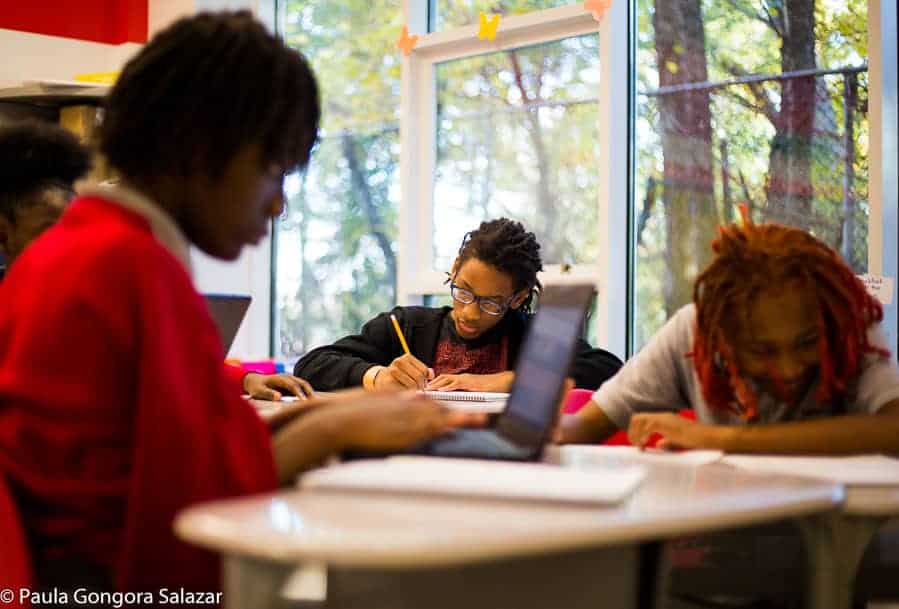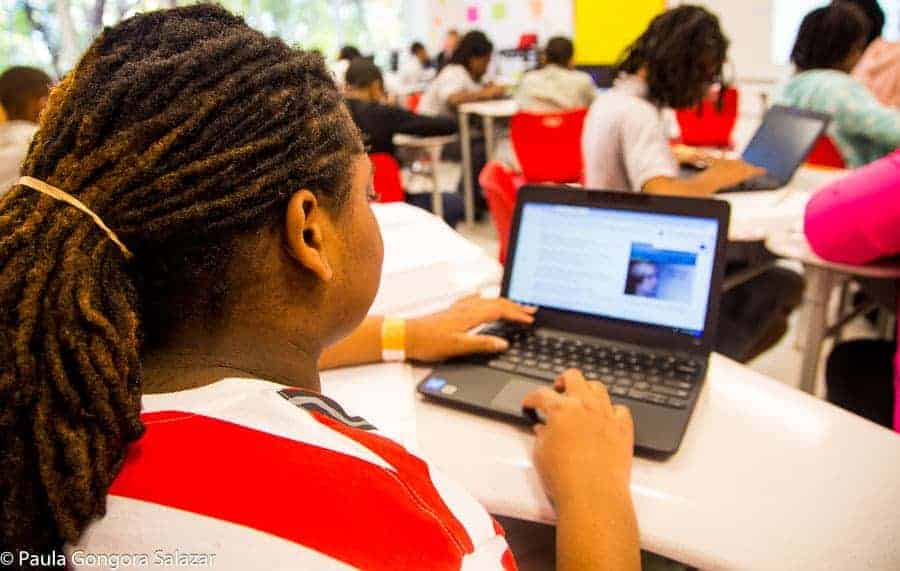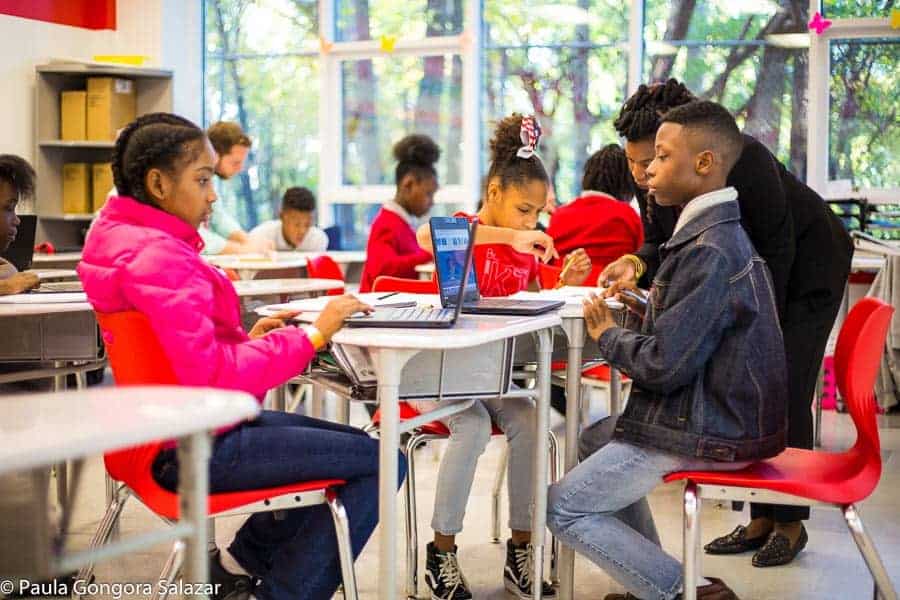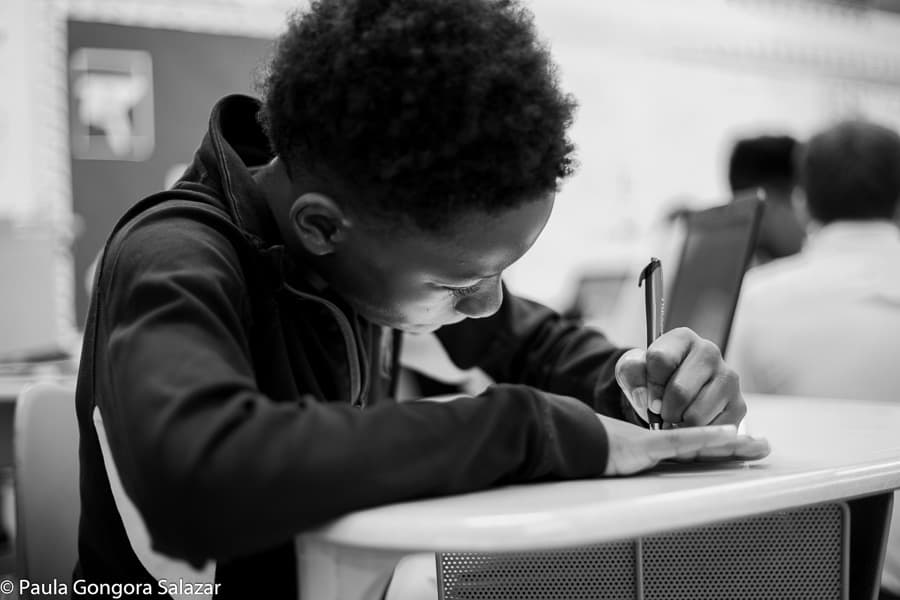
Photographing children is difficult, even under the most favorable circumstances. Kids move around a lot. Their expressions aren’t predictable. And trying to coordinate the poses and expressions of several children at once? Well, that’s why aspirin and whiskey were invented.
In a studio, with their parents helping, it’s hard. Imagine, then, what it’s like working with kids in a classroom or on a playground. As a one-time sixth-grade teacher, I know it ain’t easy! So, it came as no surprise that a client shoot in a community center with a bunch of kids would be challenging.
The client, a local nonprofit organization, wanted photos for a fund-raising brochure that would show kids interacting with adults and having a good time. The lighting was terrible. The backgrounds were distracting. There wasn’t much room to move around and try different compositions. The children were making artworks and stayed in constant motion the whole time. How do you make the best of that chaotic situation and deliver what the client wants?
The situation I just described is familiar to Paula Gongora Salazar, a DC-based photographer and videographer. Paula works with a lot of clients, from large, international organizations to small, local ones. Many of these clients want photographs of children for use in a variety of places, from brochures to advertising to annual reports to press kits. I was introduced to her work recently and had the opportunity to talk with her about how she prepares for and photographs difficult client shoots that involve children. Paula graciously provided the images for this article, too.
Paula’s background plays a role in her ability to adapt and make the best of challenging situations. Born in Colombia, she always loved things related to art, so she studied visual arts. After moving to Barcelona, she studied photography and videography and, then, in London studied fashion photography. She has degrees in film production and direction, and in fashion photography, and taught herself graphic design. Now, she mostly does fashion and documentary work. Her background helps her figure out how to help clients tell their stories. Our wide-ranging conversation can be distilled into five key tips for photographing children for clients.

It’s crucial to know the story in advance.
You have to know who the ultimate audience is for your photos. You have to know what the end products are and what their purpose is. And, you have to know what story the client is trying to tell. How else are you going to know what kinds of photos you need to capture?
Sometimes, the client isn’t clear about or hasn't thought through what they want. It’s your job, as a photographer, to help them clarify and distill their needs down to more precise deliverables. Otherwise, you might get a vague and unhelpful shot list or no list at all.
“I have to ask a lot of questions,” Paula says. “I dig really deep to make sure I and they really understand what they want. Many times, they don’t really know what they want. What they think they want is not what they really need.” Sometimes the client doesn’t have enough photography or design knowledge to even know what they need. It becomes your job as a professional to help them figure it out. “Do they need stock photos or something that really shows what’s going on and makes an emotional connection? Stock may be OK for a website, but not for a fundraising brochure. Sometimes I have to send them examples of stock and of reality or emotional shots to find out what they really want and need.”
In one of her recent jobs, she helped the client narrow down their desires to showing how kids engage with a specific education program through photos of kids at work, kids doing research, kids working with each other and kids working with a teacher. They wanted photos that would create an emotional connection with the viewer. That’s clear and specific enough to be actionable.
Be aware of everything

You have to be conscious of every element in the environment when you walk into the room. What’s the light like and where is it coming from? Is the background cluttered or simple, colorful or drab? How is the room arranged and what are the kids actually doing? Paula doesn’t even take out her camera until she has a good sense of the room and can start planning her compositions.
In that recent shoot, Paula noticed that the school building had lots of bright, beautiful colors and determined that color would play a big role in her shots that day. In one room, the walls were bright white and red. They would be good backgrounds that would make her subjects pop. A window gave a view of the outdoors, with a couple of green trees, providing a complementary color to the red wall. If a wall is cluttered with a lot of papers, she can minimize its impact in the photo with a very shallow depth of field. A nice, soft light was coming into the room through the windows but, the farther away from the windows you got, the more the light was from harsh, overhead lights. The light suggested that more intimate, quiet portraits of kids at work would be shot near the windows. The kids were working on a project, which meant that they’d be in the same place for a while, concentrating on what they were doing. In turn, that meant she had some time to move around and get the composition she wanted.
Paula used to teach photography, which gives her an insight into how classroom work. That helps her anticipate things and keeps her presence from being distracting. You don’t have to be a former teacher: just be observant. See what the kids are doing and how they are moving and behaving. Patterns emerge as you watch which can help you predict movements and behaviors.
In addition, you have to know if there are photo releases for all the children. A couple of the children in this shoot did not have photo releases, so they couldn’t be included in any shots. Paula developed plans to exclude them from any compositions. If a kid is working as part of a group, she’ll use a natural frame, like a chair, to block him. If a child working alone, she’ll avoid shooting that area or position another kid or object to obscure him.
Have an open dialogue with the children
Paula says she doesn’t want to instruct or pose the kids. Telling kids what stance or expression you want typically results in stiff and awkward, unnatural photos. It’s better to watch what they are already doing and emphasize or modify that. And it’s usually easier when you show them what you want by doing it yourself, or when you say that “I like what you are doing here” or “I like what your hands are doing. Can I take a picture of that?”
“Kids today grow up with cameras and are really comfortable around them . . . when they are in charge,” Paula notes. “But, when somebody else is in control, they’re really not comfortable, especially when they don’t know how the photos will be used or where they will be seen.” Once they know what’s going on, kids tend to relax. Paula tells them “I’m going to be taking a thousand pictures, but I’m only going to use a few and they’ll be the best ones.”
Often, as soon as you take out your camera, kids will come running up asking “Can you take my picture?” Paula tells them “OK, I will take a photo of you but at the end of the period. First, I have to get my other shots.” Once satisfied that you will eventually photograph them, the kids can turn their attention back where you need it.
“The kids are not there for you. You are there for them. You have to adjust to their pace and work with what they’re doing.”

Open wide to narrow down and close in
“I try to avoid using flash, if I can avoid it.” Paula says “Flash really distracts the kids and makes everything look more staged.” Working with available light, she often has to shoot wide open at apertures of f2.8 to f4.
Shooting wide open has several advantages besides avoiding flash. Paula feels that the best shots are taken from far away or up close and tight. Mid-range shots have less impact. A wide aperture often forces you to get close and that looks very intentional. It isolates your subject and blurs out the background. Backgrounds in schools are often really distracting, full or papers, art projects and colorful posters. Blurring them takes visual attention away from the background and squarely onto your subject. In addition, you want to avoid identifying the kids or the school and the bokeh of a wide aperture avoids any chance of having the child’s or school’s name visible on a bulletin board or project.
Being close and using a shallow depth of field also opens up possibilities to shoot what the children’s hands or eyes are doing and to photograph the details that can be important elements of telling the story. Proximity and an open aperture also make for good shots of kids working together and talking with each other, or of a teacher or volunteer working with one or two students.
Shots from farther away are better at conveying the setting, atmosphere and mood. Distant shots can give a better sense of the facilities, the number of people participating, and so forth, which are essential elements in some, but not all, stories.

Get Down
Most of her shots are taken when she’s kneeling or sitting down at the same level as the kids. Shooting from above makes the kids seem smaller. “Unless you’re intentionally shooting from a teacher’s perspective, get down to the children’s eye level,” she says.
Paula takes a lot of photos while on a shoot. When she gets a group of kids working together, she’ll take multiple shots: a few with the focus on the first child’s face, then a few with the focus on the second child’s face, and so on. This way, she has sharp photos of every kid’s face and can pick the best overall composition and swap out faces, if needed.
She also takes a lot of photos as bursts. Just like you see at a presidential news conference, you never know the exact moment that the best pose and facial expression are going to happen. Taking a burst of shots dramatically increases your chances of getting a sharp photo with a good pose and facial expression when the subject isn’t blinking.

Several Shades of Gray
As Paula is shooting the assignment, she’s also thinking about which shots will work as black and white photos. Clients usually don’t ask for black and white images but Paula’s experience has taught her that, at some point, clients will need them. Often design requirements on a print piece or web page will call for grayscale and it’s far better to have images that were composed for B&W than to convert one that wasn’t. And, once they have some, clients seem to find other uses for monochromatic images they hadn’t thought of before.
B&W images are better at toning down a busy or colorful background so as to make the subject pop. In addition, monochrome photos are frequently better at conveying emotion and stripping out unnecessary details.
So, as she goes through the shoot and again in post-processing, Paula’s looking for what works in black and white. Sometimes she’ll send both versions of a shot. Sometimes she’ll only send the B&W version. She’s never had a client ask her to convert a monochrome back to color or a color shot to B&W but she has had clients thank her for including B&W images.
“Don’t overthink it, but be prepared,” she concluded. “If you have to ask questions, ask and keep asking until you know the story.”
Paula Gongora Salazar is the owner of Pau Photography, specializing in documentary and fashion photography and videography. Instagram: paugs.photo

Thank you so much for sharing this information, this will surely help me in my work and therefore, I would like to tell you that
very fewer people can write in a manner where the reader understands just by reading the article once carefully. Thank for the
information.
Thanks, this is very important information to me, actually it is very helpful to us use for my work. thanks for sharing useful information.
Appreciate it for all your efforts that you have put in this. very interesting info . You made some nice points there about the Photography Tips. Thank you for information…